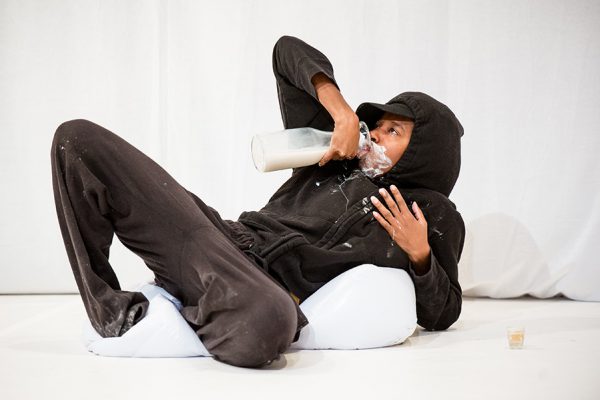Philip Szporer: Nothing is a given in Dana’s Michel new work, Mercurial George. In the first minutes, we see her crawling across the stage on all fours; her head is shorn of its trademark dreadlocks; she’s bare-breasted, wearing white tights and sneakers. When she settles into place, surrounded by large bags full of objects, she appears broken, unsettled, somewhat dazed. The body is reticent, a hand searches, reaching out, and then abandons the task. It’s as if she’s suspended in uncertainty. Physically, it’s uncanny how her bony angularity, her ribs sticking out, seems fragile, and yet in another instant she can project a strong athletic body.
Language is another important element in the performance. At first, all we hear is a wan “No,” which she repeats several times. It’s as if she’s in infancy, unable to utter well-articulated words or phrases. Or as though she was sitting listening intently to her mind’s wanderings. Then there would be a shift, and she’d become distracted by whatever was within arm’s reach. But that moment disappears in an instant. Her body folds in on itself. At times, her face would release; her lower jaw would become slack, and then a series of murmurs and hums would unfurl.
None of what Michel is working with is easy material, and several people surrounding me seemed to fidget uncomfortably. But in order to appreciate her performance you have to just let yourself go. Try and think too hard about who she is and where she is, and why she is in a particular state, and you’ll get stuck.
Mark, what was your take?
Mark Mann: I was a bit stuck. I felt no need to make more of Michel’s character than what she presented in the performance, but I did become fixated on the question of whether or not we were supposed to laugh.
The first time laughter scattered through the audience, I was honestly shocked. To me, there was nothing funny about Michel’s embodiment of an outcast, despite the streak of absurdity running through it. If there is a real-world equivalent to her character in Mercurial George, it is a mentally ill homeless person with palsy or delirium tremens. That’s probably not the exact description she would offer, but her movements and demeanour make clear references to disorganized thoughts, disease and disability. We don’t have to be precious or dainty about these conditions; however, it makes me cringe to think that she would be employing vulnerability in order to make a sly joke that the audience either gets or doesn’t.
More likely, the laughter revealed our discomfort, rather than Michel’s desire to entertain. Mercurial George is an extremely rigorous character study, focusing on the solitude of the rejected. Within that solitude, we find charm, courage, defiance, triumph and even humour. (Yeah, I laughed too, in the end, when she buried her face in a big blue ball of dough.)
But whenever we see someone in the park or on a street corner who occupies a world of their own devising, who seems neither capable nor interested to make themselves intelligible to others, we don’t continue to look at them, because that would be staring. What’s shocking — and brilliant — about Michel’s performance is that she makes us stare at her. We can’t really access the space that she creates for herself onstage, and so we can only gaze in from the outside. Though she’s the outcast, we’re the ones who are excluded.
Philip, how does that reading fit with yours? What do you think Michel was offering the audience, once we move through our discomfort?
PS: This is one-on-one performance. Her skill, I feel, is to directly connect to us, even if that means that some audience members feel discomfort. And that brings up issues of who is watching, and where she’s showing the work. I think, and I may be wrong, that if this show were presented somewhere in the Caribbean, the reading might be different, and I’m guessing Michel might be receiving reactions of the public differently too.
I liked that she just lets loose in her world. But you’re on to something, Mark, when you suggest that we have moments when we are voyeurs. Mercurial George is not so much about virtuosity; it is about watching, observing. What is the space we give to watch? Like you say, we often turn our gaze away. There was a fascinating moment in the piece, when she is walking, stumbling through the space, and she’s wearing a big old faux fur coat, a tuque, has a bag of bread in one hand, a toy horn in another, and she’s sporting a crazy headpiece, something like a crown, which features a photo of Michel looking straight ahead. So when she is shifting about, her head tilted down, her eyes focused towards the floor, her photo is looking directly at us. It’s very wonderful and strange.
Then there are the cultural markers. The whacking big piece of ginger, for instance, that she attempts to skewer. I couldn’t help but cackle. Then I was more afraid that she was going to harm herself with that pointy extending BBQ fork. And let’s just talk about hair some more. Her previous piece, which won all that acclaim, Yellow Towel, was, in part, about hair. Now she’s cut it back, close-cropped. The Nigerian writer Chimamanda Ngozi Adichie writes that as a black woman your hair ‘rules you.’ She says, ‘I am a bit of a fundamentalist when it comes to black women’s hair. Hair is hair, yet also about larger questions: self-acceptance, insecurity and what the world tells you is beautiful.’ I just found it interesting that when Michel sports a dread wig at one point in the piece, she begins to speak in a Caribbean lilt. ‘Don’t be afraid to tell,’ she says.
Those words to me are powerful. And I applaud her courage in expressing that thought, in her own manner, in her own time.
MM: Agreed. For me the most arresting moment in the performance came at the very end. She places herself behind a row of lights at the back of the stage, as if taking a respite from our collective gaze, and bends over at the waist to let her hair fall to the floor. Carefully, she drapes a white shawl over her head and disappears into it for a second, as though cocooning. Then she wraps her hair up into the fabric and arranges it on top of her head, transfiguring herself from the otherworldly being that she has embodied thus far to a much more familiar character. In the final minutes of the piece, she marches in a wide circle around the stage with a determined gait. Though her body still totters at the edge of her control — her right hip twisted open, as if out of joint, and her arms making slight, involuntary movements — she looks powerful and unstoppable. It’s a perfect synthesis of all the heroic and tragic elements in the character that she channels; I don’t think I’ve ever seen a more fitting conclusion to a dance piece. In this last vision, Michel brings together the various paradoxes that make her work so unique: she’s both generous and demanding, both haunting and painfully, inescapably real.
Tagged: Choreography, Contemporary, Performance, Montréal , QC





